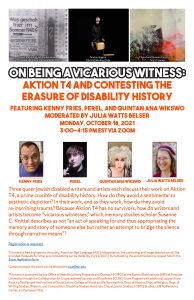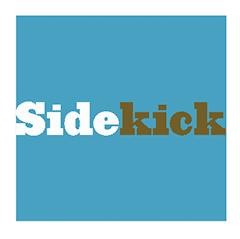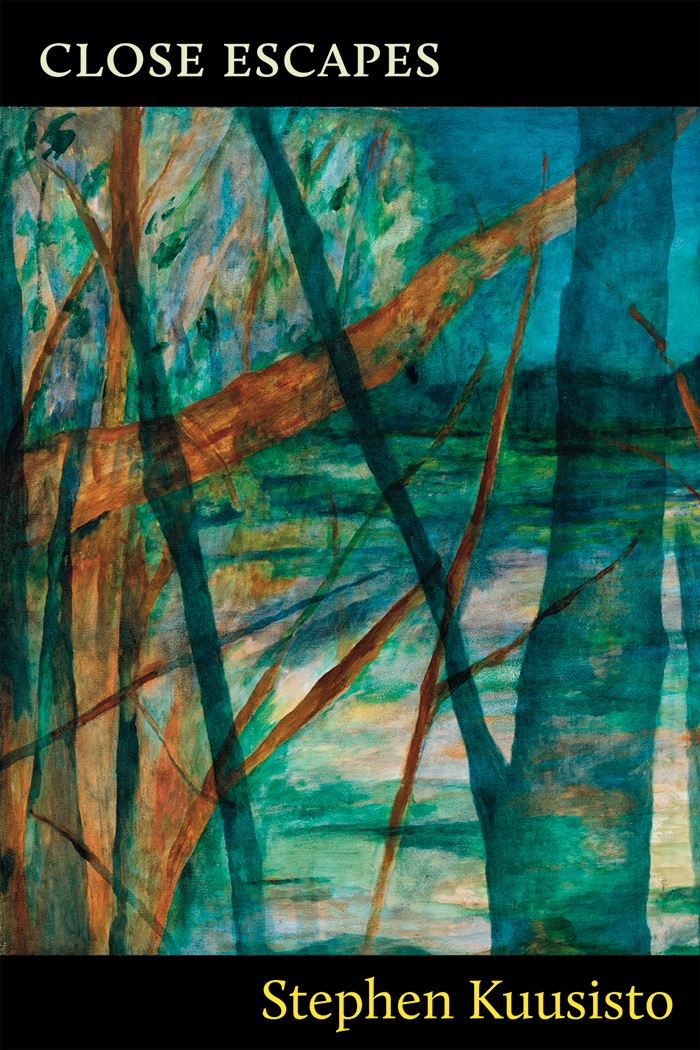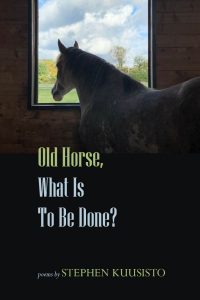
Content Warning: Due to the nature of this content and subject matter, discretion is strongly advised.
On October 18, 2021, three queer Jewish disabled writers and artists discussed their work on Aktion T4, a prime crucible of disability history. How do they avoid a sentimental or aesthetic depiction? In their work, and as they work, how do they avoid re-inscribing trauma? Because Aktion T4 has no survivors, how do writers and artists become “vicarious witnesses,” which memory studies scholar Susanne C. Knittel describes as not “an act of speaking for and thus appropriating the memory and story of someone else but rather an attempt to bridge the silence through narrative means”?
- Bodies of Work: Network of Disability Art & Culture – “Bodies of Work is a network of artists and organizations whose art showcases and celebrates the disability experience. From the local to the international, our bodies of work explore innovative forms of artistic expression, derived from unique bodies and minds. We explore the disability experience, advance the rights of disabled people, and widen society’s understanding of what it means to be human.”
- A Creative Capital Gathering in Berlin: Discussing Gender, Disability And Human Rights In Germany – “At the 2013 Creative Capital Artist Retreat, awardees Kenny Fries (2009 Literature) and Quintan Ana Wikswo (2013 Emerging Fields) discovered deeply compelling intersections in their work around the Jewish/queer/disabled body in Germany. To their great delight, they realized they’d both be working on those intersections in Berlin that autumn—Kenny to begin a new book, and Quintan to exhibit her interdisciplinary work at The Jewish Museum in Berlin. The pair immediately devised a plan to organize a salon-style gathering of Berlin-based artists, activists and scholars whose work focuses upon gender, disability, ethnicity and genocide in Germany. When Creative Capital stepped in with financial support through the Grantee Gatherings program, Kenny opened the doors to his apartment and a stimulating, provocative and profoundly generative event took shape.”
- Julia Watts Belser – Bio and Featured Works
- Kenny Fries
- Before the ‘Final Solution’ There Was a ‘Test Killing’ – New York Times essay by Kenny Fries, including content from his upcoming book: “Too few know the history of the Nazi methodical mass murder of disabled people. That is why I write.”
- “Disability Can Save Your Life, for Stacy Park” (YouTube audiotext). “‘Disability Can Save Your Life,’ is written in a hybrid form, between poem and essay, a collage also including a brief passage from my book In the Province of the Gods, as well as references to other related history, including the killing of the disabled in the Nazi Aktion T4 program.”
- What Happened Here in the Summer of 1940? (YouTube Video Series by Kenny Fries) – “In a series of six interrelated short videos, Kenny Fries reads excerpts from his forthcoming book Stumbling over History: Disability and the Holocaust. The readings are supplemented by personal and historical photographs from his visits to the six Aktion T4 killing sites, where disabled people were mass murdered during the Third Reich.”
- Perel – bio and selected recent works
- Life (Un)Worthy of Life, Season 3, Episode 1: Chicago and on the Zoom Ramp of the Universe (YouTube video) – “For the past two years, multidisciplinary artist Perel has been presenting this talk show throughout Germany featuring interviews with writer Kenny Fries. “Life unworthy of life” is an official designation used by the Nazi regime to decide who would be killed or spared. It was used to justify the killing of disabled people under the Aktion T4 program. Perel changed the construction of this term to create a space for the open discussion of legacies of oppression. Because of the coronavirus pandemic, Perel and Kenny had to go virtual for their Chicago performance, produced by Bodies of Work. The video version is based on Perel and Kenny’s Zoom discussion with 11 eminent Chicago-based disability artists, scholars, and activists, about T4, eugenics and the coronavirus pandemic, and how best we might move forward as a community.
- Quintan Ana Wikso
- THE AKTION T4 SUITE: SEVEN PROJECTS BY QUINTAN ANA WIKSWO – Each of the individual links below contain click-to-enlarge full-size photographs, and Vimeo links to the installations, films, and performances. The literature section is work that has been published; the organization of these links is in-process.
- CHARITÉ – An autobiographical project in photography, essay, film, and performance regarding the queer women affected by Aktion T4 and the lengthy careers of its doctors, their teachers, and their students at the Charité hospital from 1920 to today
- ARTIST STATEMENT: https://www.quintanwikswo.com/projects/charite/
- PHOTOGRAPHS: https://www.quintanwikswo.com/projects/charite/#visual-art
- ESSAY: https://www.quintanwikswo.com/projects/charite/#literature
- FILM: https://www.quintanwikswo.com/projects/charite/#film
- PERFORMANCE: https://www.quintanwikswo.com/projects/charite/#performance
- KLITZEKLIENE URNE / TINY URN – An autobiographical project in performance, photography, and literature on the murder of the infant Gerhard Herbert Kretschmar in the Aktion T4 Bavarian Section.
- ARTIST STATEMENT: https://www.quintanwikswo.com/projects/klitzekleine-urne-tiny-urn/
- VISUAL ART: https://www.quintanwikswo.com/projects/klitzekleine-urne-tiny-urn/#visual-art
- LITERATURE: https://www.quintanwikswo.com/projects/klitzekleine-urne-tiny-urn/#literature
- READING: https://www.quintanwikswo.com/projects/klitzekleine-urne-tiny-urn/#performance
- FOUR STRATEGIES FOR FILING – An autobiographical project on the taxonomy of Jewish body specimens. in performance, poems, and photographs from my work in the archives of the Vienna T4 body parts archive (secret, concealed existence).
- ARTIST STATEMENT: https://www.quintanwikswo.com/projects/four-strategies-for-filing/
- LITERATURE: https://www.quintanwikswo.com/projects/four-strategies-for-filing/#literature
- FILM: https://www.quintanwikswo.com/projects/four-strategies-for-filing/#film
- PERFORMANCE: https://www.quintanwikswo.com/projects/four-strategies-for-filing/#performance
- SIX NIGHTS IN IGNAZ GÜNTHER HAUS – An autobiographical commission regarding fetishization, eroticization, and othering of the Jewish disabled body in historical and contemporary German society.
- ARTIST STATEMENT: https://www.quintanwikswo.com/projects/six-nights-sleeping-in-ignaz-gunther-haus/
- LITERATURE: https://www.quintanwikswo.com/projects/six-nights-sleeping-in-ignaz-gunther-haus/#literature
- PERFORMANCE AT JEWISH MUSEUM + STILL IMAGES FROM PERFORMANCE: https://www.quintanwikswo.com/projects/six-nights-sleeping-in-ignaz-gunther-haus/#performance
- VOLKERKUNDE / ANTHROPOLOGY – An autobiographical project in documentary film and literature surrounding the The Anthropology Museum in Vienna, with secret archives from T4.
- CARRIE BURIED BENEATH CATALPA LEAVES – An autobiographical project in photographs and poems documenting Quintan Ana Wikswo’s encounters and arrests while investigating the Action T4 killing programs in Virginia.
- NONAGON FOR THE DEAD WHO ARE RISING – A call to arms for murdered people who are disabled, and a tribute to disability activist Robin Kilson (1952-2015). An abstract exploration of the continuum of T4 over centuries, known by many names.
- ARTIST STATEMENT: https://www.quintanwikswo.com/projects/nonagon-for-the-dead-who-are-rising/
- PHOTOGRAPHS: https://www.quintanwikswo.com/projects/nonagon-for-the-dead-who-are-rising/#visual-art
- LITERATURE: https://www.quintanwikswo.com/projects/nonagon-for-the-dead-who-are-rising/#literature
- PERFORMANCE DOCUMENTATION PHOTOGRAPHS: https://www.quintanwikswo.com/projects/nonagon-for-the-dead-who-are-rising/#performance
- CHARITÉ – An autobiographical project in photography, essay, film, and performance regarding the queer women affected by Aktion T4 and the lengthy careers of its doctors, their teachers, and their students at the Charité hospital from 1920 to today
- THE AKTION T4 SUITE: SEVEN PROJECTS BY QUINTAN ANA WIKSWO – Each of the individual links below contain click-to-enlarge full-size photographs, and Vimeo links to the installations, films, and performances. The literature section is work that has been published; the organization of these links is in-process.
Updated 11-23-2021


